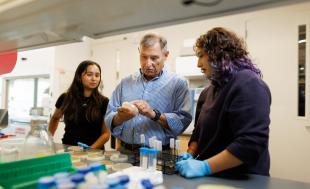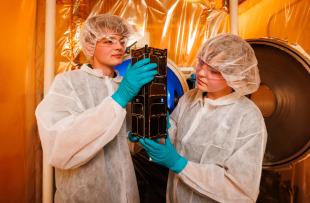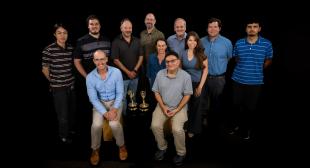Keep Clam and Carry On: Researchers Work to Bring Back a Pismo Tradition
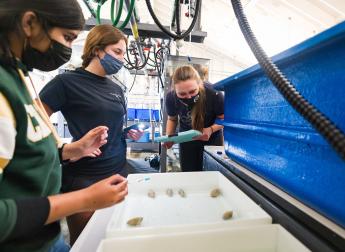
The last time anyone could buy a bowl of chowder made with Pismo clams on the Central Coast was 70 years ago. A group of Cal Poly researchers wants to make that a reality once again — and change the future of local fisheries in the process.
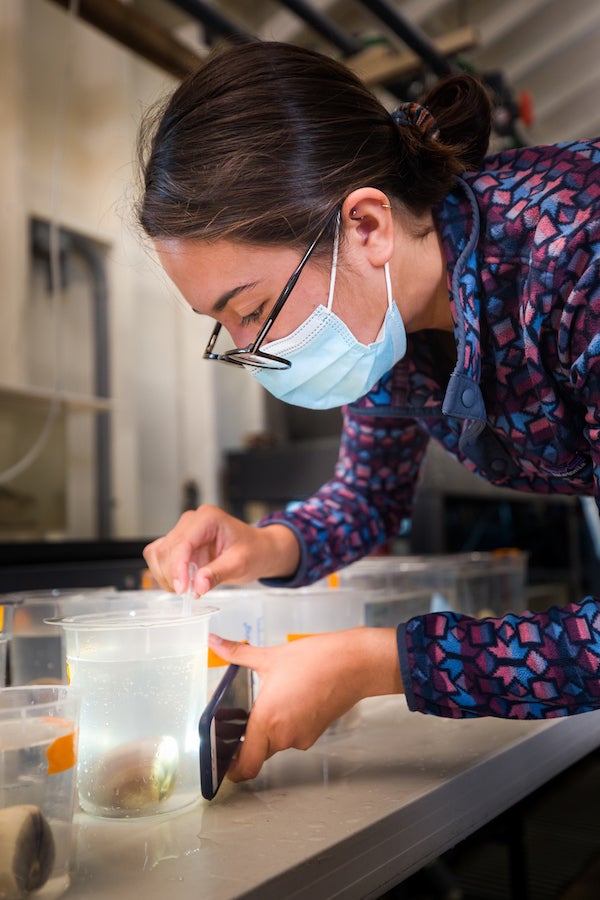
“One of our current goals with Pismo clams is to explore ways to spawn them as the first step toward developing them as a new, local aquaculture species,” said biological sciences Professor Ben Ruttenberg, one of the leads on the project and the director of the Cal Poly Center for Coastal Marine Sciences.
If the team is successful, “There could be local commercial production of Pismo clams.”
In a lab at the end of the Cal Poly Pier on a recent overcast morning, surrounded by stacked tanks of marine life, three undergraduate students took turns injecting the clams’ feet with serotonin in a tank and then moving them into separate water-filled containers to watch for the release of sperm or eggs. Graduate student Marissa Bills, who’s leading the spawning effort, walked around and observed her fellow researchers, offering advice or answering their questions.
Once the clams release their sperm or eggs, the team will attempt to fertilize them. If all goes well, they will have baby clams.
The students are trying to come up with clear-cut processes that can be used to reproduce Pismo clams for aquaculture farming or — one day long in the future — for restoration projects along California beaches.
“The great thing about Pismo clams as an aquaculture species is that they’re filter feeders, so once they’re through the early juvenile phase, not only do they not need any supplement food, but they also act as natural water filters,” Ruttenberg said. “It’s a way for us to produce protein really, really efficiently with little to no environmental impact, helping both the environment and the local economy.”
More than 60 years ago, the city of Pismo Beach dubbed itself the “Clam Capital of the World,” due to the abundance of Pismo clams. But in the decades since, the Pismo clam population has steadily declined. People can still legally harvest Pismo clams recreationally if they measure at least 4.5 inches in diameter, but a clam that large hasn’t been found on the beach since 1993.
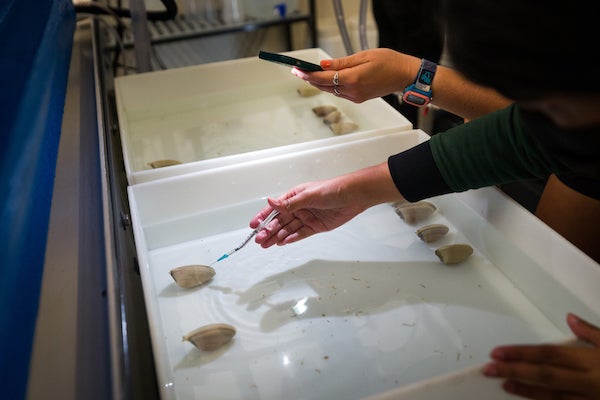
Six years ago, Pismo Beach city officials approached Ruttenberg and asked if he and his colleagues could help bring the species back to its former glory, citing its importance to local tourism. But the issue soon became more complex than just bringing the clams back.
“As we dug into this, we realized there were some studies of their basic biology in the 1940s and 50s, but very little work since then — and a lot of that work was not necessarily all that clearly documented,” Ruttenberg said. “We’re not quite starting from zero, but pretty close to it.”
The aquaculture part of the project, which just launched this summer, is the newest research component. It’s so new, in fact, that it’s given the undergraduate students a unique opportunity to start at the very beginning of a research project.
During the spawning experiment that morning in the lab, third-year biological sciences student Aimee Armstrong takes a break and gestures to giant blue plastic containers off to the side, which hold more Pismo clams. She and the other students built these and set them up for the experiment, she explains.
“This summer, we’ve started a bunch of long-term experiments,” Armstrong said. “I think it’s a great opportunity because a lot of times, students learn the ropes by going into a lab where research has been ongoing for a while, but we’re getting to start from scratch.”
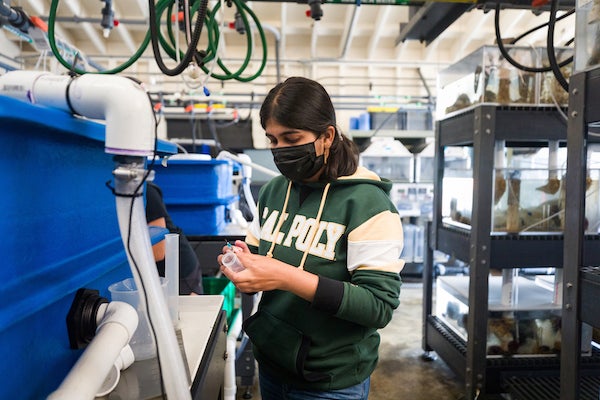
The students’ responsibilities this summer have varied from day to day, with the hands-on nature of their work sending them to some unexpected places, like Home Depot to buy plumbing parts for use in the tanks they built.
“I’m getting to learn so many different skills,” said Sara Goel, a third-year biological sciences major. “It’s a lot of us figuring things out as we go, which is interesting because we get to witness the trial and error that comes along with doing new research experiments.”
As a graduate student, Bills said having the facility at the Cal Poly Pier and the latitude to try many different things to reach the group’s goal has been an excellent way to learn.
“The undergraduates have not done the same thing twice,” Bills said. “They’ve had a really dynamic summer, and I love that we get to do so many different things, doing things where we don’t totally know if they’re going to work until we try it. We are doing lots of Learn by Doing and learn by failing, so it’s been a great example of the process of science.”
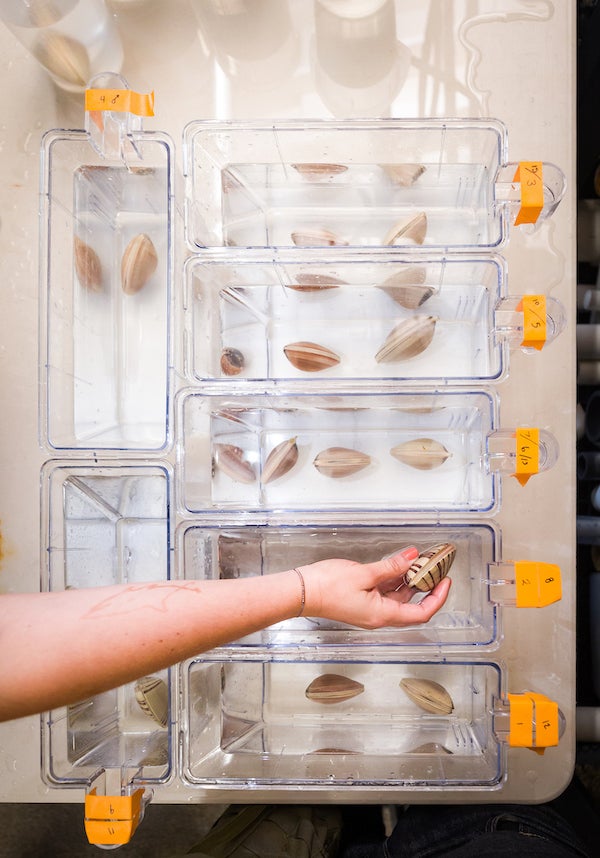
Kevin Johnson, a California Sea Grant Aquaculture Extension Specialist at Cal Poly and co-lead on the project, said the students have helped the whole team improve by contributing their input and points of view.
“Everyone we’ve had out here has been here not just to work hard, but to really come out with a focus on trying to understand what they’re doing,” he said. “You get the benefit of the students’ brains thinking about the problem and asking you, ‘Have you thought about this?’ and you go, ‘No, I hadn’t. That’s a great idea!’”
That collaboration has extended to ongoing portions of the project as well.
Thanks to Bills, the team has started tagging Pismo clam shells with QR code stickers, which will hopefully help the team keep better track of the clams on Pismo Beach. Any member of the public who sees a clam can scan the QR code, which takes them to a site where they can record basic information such as where they found the clam, whether it’s alive or dead, and its size.
“It’s hopefully going to turn into a really cool community science project to get people involved, because there’s a whole lot of clams on Pismo Beach and our team, though large, cannot possibly hope to find them all again,” Bills said. “The community is really invested in these clams. Any way for us to leverage that for the benefit of science is a win-win for everybody.”
The work Ruttenberg, Johnson, Bills and their team are doing on the Pismo clams has impacts that will reverberate beyond the Central Coast, and beyond the clams themselves.
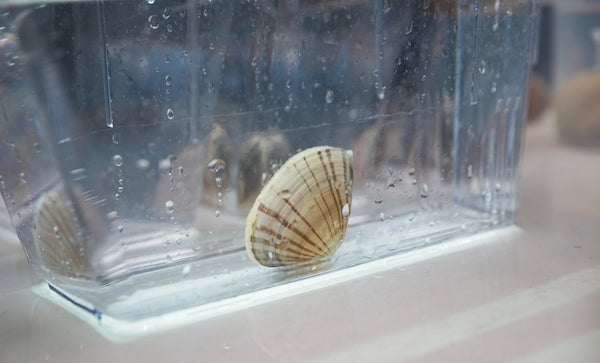
“We can apply what we’re doing and what we’re learning as a model for how we can rehabilitate a local native species in California,” Ruttenberg said. “We want to change the world, one Pismo clam at a time.”
Don't want to miss any cool Cal Poly News stories? Sign up for our monthly newsletter, the Cal Poly News Recap!

